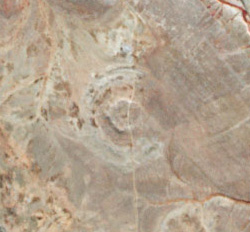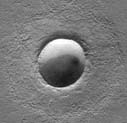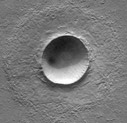While high over the grasslands of Kazakhstan, the Terra Earth-observing satellite saw something interesting… can you spot it in this image?
Not so easy, is it? But if you look just left of center you’ll see this:
See it there, right in the center? It’s the Chiyli impact crater, an ancient scar from a cosmic collision. The crater is roughly 1.5 km across (about a mile) – about the same size as Meteor Crater in Arizona – meaning the object that created it was something smaller than a football field, moving at perhaps 30 km/sec (20 miles/sec). It hit about 46 million years ago, give or take. Long after the dinosaurs, but long before us, too. Note that it’s a double-rimmed crater too, which sometimes form in large impacts depending on the conditions of the impactor and the ground.
This is a false-color image, at least part of which is in the infrared; vegetation appears red, water blue, and bare land is “earth tones” (browns and tans). This sort of imagery allows scientists to investigate how vegetation, land, and water change over time.
 When I first saw this image, I didn’t see it as a crater, but more as a raised annulus, a ring in the ground. I knew immediately that this meant that in the picture, the sunlight was coming up from the bottom, and it turns out that’s correct. It’s a cool and optical illusion; when we see craters illuminated from below, they look like domes, and vice-versa. In the picture here, I flipped the image and now, to me at least, it looks more like the depression that it really is. The wide inner rim is more obvious, too.
When I first saw this image, I didn’t see it as a crater, but more as a raised annulus, a ring in the ground. I knew immediately that this meant that in the picture, the sunlight was coming up from the bottom, and it turns out that’s correct. It’s a cool and optical illusion; when we see craters illuminated from below, they look like domes, and vice-versa. In the picture here, I flipped the image and now, to me at least, it looks more like the depression that it really is. The wide inner rim is more obvious, too.
Here’s an even better example:
 |  |
| Is it a dome… | … or a crater? |
It just goes to show you that finding evidence of extra-terrestrial events on Earth can be tough, and even when you find them you can’t rest easy. They’re apt to fool you one way or another.